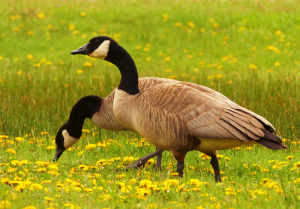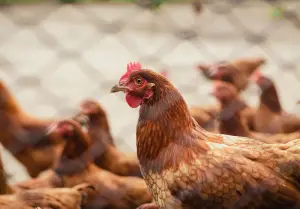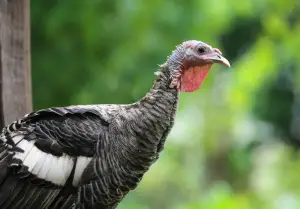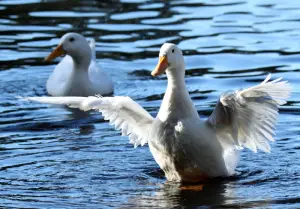Can Ducks Breed With Geese, Chickens, Turkeys, & Different Breeds?
Have you ever heard the term “TurDucKen”? Is this some kind of a turkey/duck/chicken hybrid straight from the lab of Dr. Frankenstein? In truth, the reality isn’t quite that exciting. While “TurDucKen” is a legitimate term, it refers to a dish created when a turkey is stuffed with a duck that is itself stuffed with a chicken (okay, maybe it is exciting). In all seriousness though, is a turkey/duck/hybrid possible?
Can ducks breed with other species of domestic fowl? Ducks cannot successfully breed with geese, chickens, turkeys, or other species of poultry or fowl (though attempts can at times have disastrous consequences). Ducks can, however, successfully breed with other ducks, though any Muscovy/Mallard offspring will be infertile.
Read on to learn more about duck cross-breeding, and why ducks are unable to successfully breed with other species of fowl.
Can Ducks Breed With Other Ducks?
Of course, ducks breed with one another to produce offspring. But there is more to this question than one may think. Almost all of our domestic duck breeds share ancestry with the Mallard.
Ducks can absolutely cross-breed with one another, just as chickens (or cattle, or dogs) of different breeds can successfully breed. In fact, this is how every new breed of any livestock or pet has been developed – by selectively breeding individuals and bringing in new genetics until you have accomplished your breeding goal.
We prefaced the previous paragraph with “almost all” duck breeds derived from the Mallard. There are actually two different species that make up our domestic ducks. The Mallard-derived ducks, and the Muscovy. The Muscovy makes a wonderful, quiet meat bird that is a very popular addition to many homesteads and larger operations. There is also enough of a genetic difference between the two species to allow for successful mating, resulting in infertile “Mule Ducks”.
Mule Ducks
A Mule Duck is a Muscovy/Mallard-type crossbreed. They are infertile, leaving the offspring unable to breed at all. If left to nature, Mules would not be as commonly found as other ducklings, for two reasons. The first is that these two duck species, while able to cohabitate peaceably, prefer to stick within their own separate flocks.
A Pekin or Cayuga, for example, will usually prefer to hang out with other Mallard-derived birds than a Muscovy. These genetic differences also result in some behavioral differences – Muscovies tend not to spend as much time in the water as Mallard ducks, for example. So the cross-breeding of Muscovies and Mallards will not occur as frequently as breeding within the two separate species, simply because they will usually not spend as much time together.
The second reason Mule Ducks will not occur as often if left to their own devices is that a Muscovy/Mallard union will only result in fertile eggs around 30% of the time. For this reason, artificial insemination is popular in the breeding of Mules, bringing the success rate up to 80%.
Why bother going through the trouble of artificial insemination to create Mule Ducks? Two of the most popular meat ducks are the Pekin and the Muscovy. Muscovies have significantly leaner meat than the Pekin, but they present a couple of unique management challenges.
Pekins have a higher rate of egg production than Muscovies, making them more productive and thus, more profitable. In addition, Muscovies are unique in that the drakes are significantly larger than the females. This presents a problem in meat production because the drakes will be ready for processing much earlier than the females, leading to tactical challenges. In the same manner, if an operation were to wait to process until the females have reached market weight, the drakes will be too large.
Many producers have realized the benefits of crossing the Muscovy with the Pekin, giving them a productive yet lean and flavorful meat duck with white feathers (and therefore a more attractive carcass). To boot, these Mules are much quieter and more docile to keep than the nervous Pekins – Muscovies do not quack like the Mallard-derived breeds.
Can Ducks Breed With Geese? 
Ducks and geese are both waterfowl and usually live in harmony with one another. Interestingly, ducks and geese also share similar sex organs – drakes (male ducks) and ganders (male geese) both have penises, a trait that only 3% of the world’s 10,000 species of bird can claim. Considering geese and ducks are so similar in habitat, lifestyle, and genitalia, you may assume they have the ability to produce hybrid offspring.
The truth is, they can’t. Geese and ducks, if living together, might occasionally appear to make an attempt at mating, but nothing will come of the experimentation. In addition to genetics, there may be a practical challenge as well, given the typical size difference between the two species. Geese and ducks, while both waterfowl are completely different animals genetically. They are unable to breed with one another, and no duck-goose hybrid has ever been discovered or recorded to our knowledge.
Can Ducks Breed With Chickens? 
As two very different species of bird, ducks cannot successfully breed with chickens. And for anatomical reasons, there may be good reason to keep them from trying.
Chickens are not part of the 3% of birds that have penises – instead, both male and female chickens have what is called a “cloaca” – an opening they use for defecation, egg-laying, and mating, with a nub in the middle for fertilization. The vast majority of the world’s birds have cloacas instead of external genitalia, with ducks, geese, and swans being the most common outliers. So what happens when these two species with completely different sex organs attempt to mate?
A rooster (male chicken) attempting to mount a female duck is really no cause for concern. The cloaca of the rooster will not harm the organs of the female, and no fertilization can occur. A drake’s organ can absolutely harm a female chicken, however, and care should be taken to discourage this behavior.
Drakes can be particularly aggressive when it comes to breeding and are not likely to take “no” for an answer. Drakes have relatively long, spiraling penises that can cause significant injury to a hen’s internal cavity if mating is attempted, and most chicken hens are unable to shake off a determined drake. For this reason, it is recommended that you keep a rooster with your flock if you must house your drake with your female chickens. A rooster’s job is to protect his hens, and he may help your two separate flocks live in harmony.
Despite this, is there evidence of duck-chicken hybrids?
Have you seen pictures online of duck-chicken hybrids? There are a couple of anecdotes of duck-hybrid chickens, and even a couple of pictures can be found online. While we cannot say with certainty that these isolated cases are not in fact half duck/half chicken, it is more likely these unique animals were simply born with some kind of deformity or genetic peculiarity.
For example, there is a picture of a duck born in 2008 in China that appears to have the feet of a chicken – it is likely that this duck was simply born with a deformity of the feet and without webbing. The farmer is quoted as saying the animal also does not like to swim like the other ducks – this could simply be because his feet are not webbed and swimming is more difficult for him than the other ducks. Of course, it is impossible to determine these animals’ genetics with certainty without a DNA test.
Can Ducks Breed With Turkeys? 
Turkeys have the reproductive organs of chickens – cloacas instead of the external sex organs of ducks. For that reason, and because of the fact that they are two distinct species, ducks and turkeys cannot successfully breed (or mate, for that matter).
A drake is less likely to hurt a turkey hen than he is to hurt a chicken, simply because the difference in size would give the drake a challenge in mounting the hen – it would be much easier for a turkey hen to shake him off, after all. While a drake is less likely to harm a turkey hen than a chicken hen because of the size difference, there could be dangerous consequences if a tom (male turkey) attempts to mount and mate with a female duck.
A female Pekin duck, which is the most commonly found domestic duck in the United States, weighs an average of 8 pounds at maturity. A broadbreasted tom, on the other hand, can weigh as much as 50 pounds. A tom can easily suffocate, or cause other bodily harm, to a duck in a mating attempt.
Duck Breeding
As you can see, there are additional challenges to ducks breeding with other species, aside from genetics. Ducks have reproductive organs unlike those of 97% of other bird species, making them incompatible with the anatomy of most poultry.
However, this does not mean that there would be no reproductive concerns with housing your ducks with your other birds. Because of these anatomical differences, as well as the differences in size between some of the species, care must be taken to ensure no harm is done by over-enthusiastic male birds.

